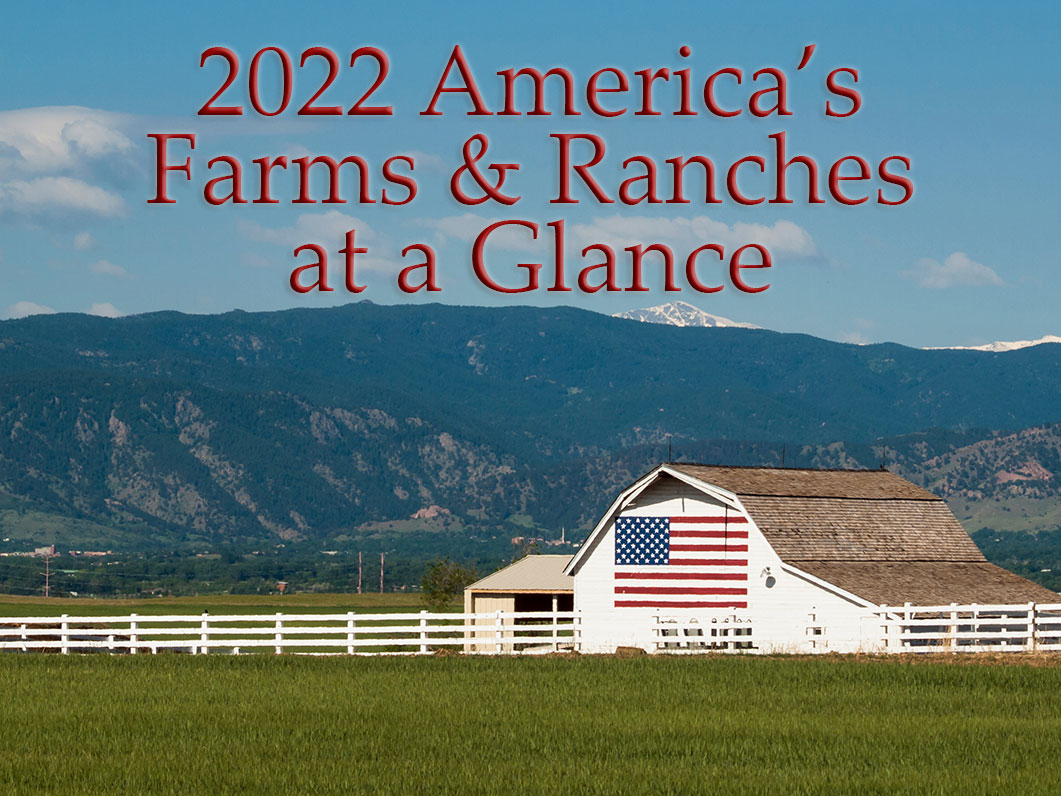In December of 2022, the USDA published its 2022 Edition of America’s Farms and Ranches at a Glance.
According to the USDA, America’s Farms and Ranches at a Glance report, previously known as America’s Diverse Family Farms, provides the latest statistics on U.S. farms, including production, financial performance, pandemic assistance, and farm household financial characteristics by farm size. ERS farm classification, or typology, is used to categorize farms into groupings to better understand conditions across the United States’ broad farm sector. This year’s edition explores farm household health insurance coverage, input acquisition practices, farm liquidity, and agritourism adoption.
USDA researchers, Christine Whitt, Noah Miller, and Ryan Olver compiled the information. They used data from the Agricultural Resource Management Survey (ARMS), an annual survey conducted by USDA, National Agricultural Statistics Service (NASS) and USDA, Economic Research Service (ERS). Most of the analysis in this report is based on a usable sample of approximately 13,716 farms from the 2021 ARMS.
According to the information in the twenty-nine-page report, most U.S. farms are small family farms; these farms operate on nearly 50 percent of U.S. agricultural land and account for 18 percent of the total production value.
In 2021, approximately 89 percent of all farms were small family farms and operated 45 percent of the agricultural land. Large-scale family farms accounted for 46 percent of the total value of production and 27 percent of agricultural land in 2021. Also, midsize family farms accounted for 18 percent of agricultural land and 18 percent of the total value of production. In total, family farms accounted for about 98 percent of total farms and 83 percent of total production in 2021. Nonfamily farms accounted for the remaining 2 percent of farms.
A variety of statistics were gathered for the report and are presented in narrative and graph formats. Topics include:
- Number of farms and distribution of farm, value of production, and acres operated by the farm typology, 2021
- Distribution of farms, land operated, and value of production by farm type, 2021
- Value of production of selected commodities by farm type, 2021
- Farms by operating profit margin and farm type, 2021
- Farms by current ratio and farm type, 2021
- Median operator household income by farm type, 2021
- Farm households with income or wealth below the median for all U.S. households, 2021
- Farm operator income per household by source and farm type, 2021
- Percent of farm household members with health insurance by farm type, 2021
- Agritourism rates by farm size, 2020 and 2021
- Direct-to-consumer sales participation by farm size for agritourism and non-agritourism farms, 2021
- Input purchasing strategies, by farm type, 2021
- Dates at which operations forward priced inputs for 2021, by input type
- Distribution of selected Government agricultural program payments and value of production by farm type, 2021
- Distribution of total reported pandemic assistance, by farm type and type of assistance program, 2021
- Federal crop insurance participants, harvested cropland, and indemnities by farm type, 2021
The reports conclusions and implications stated U.S. farming is still overwhelmingly a family business. In 2021, 98 percent of U.S. farms were family farms, accounting for 83 percent of farm production.
Small family farms made up 89 percent of the farm count and operated nearly 50 percent of the farmland but only generated 18 percent of the total value of production. The largest share of the value of farm production (46 percent) occurred on large-scale family farms. However, small family farms accounted for 47 percent of the value of poultry and eggs and 53 percent of hay production.
The share of farms with a low-risk operating profit margin (OPM) varied by farm size in 2021. Between 50 and 81 percent of small family farms had an OPM in the high-risk zone (OPM less than 10 percent)—depending on the farm type—compared with 25 and 33 percent of midsize and large-scale family farms, respectively. Some small family farms of each type operated in the low-risk zone, as did more than 40 percent of midsize and large-scale family farms.
Farm households, in general, were neither low income nor low wealth. In 2021, median farm household income (which includes both farm and off-farm income sources) exceeded that for all U.S. households but was lower than the median income of all U.S. households with self-employment income. About 38 percent of farm households had income below the median for all U.S. households, and 2 percent had wealth below the U.S. median in 2021.
USDA Conservation Reserve Program (CRP) payments went to different types of farms than other Government payments. CRP payments target environmentally sensitive cropland, with most payments going to retirement, off-farm occupation, and low-sales farms. In contrast, most commodity-related and working-land payments went to family farms with a gross cash farm income (GCFI) of $350,000 or more.
Most of the pandemic assistance to U.S. agriculture came from the U.S. Small Business Administration. Farms also received USDA assistance from the Coronavirus Food Assistance Program (CFAP), Pandemic Cover Crop Program (PCCP), and Pandemic Livestock Indemnity Program (PLIP). Midsize and large family farms received a greater share of total pandemic assistance than very large family, small family, and nonfamily farms.
Overall, 14 percent of farms participated in Federal crop insurance in 2021. However, 62 percent of farms growing row crops purchased Federal crop insurance. Indemnities from Federal crop insurance were roughly proportional to acres of harvested cropland. Midsize and large-scale family farms together accounted for 66 percent of all harvested cropland acres and received 84 percent of indemnities from Federal crop insurance in 2021.
If you would like to download the full report, Click on the link: https://www.ers.usda.gov/webdocs/publications/105388/eib-247.pdf?v=1080.6
If you would like to watch the report webinar, view it below.


